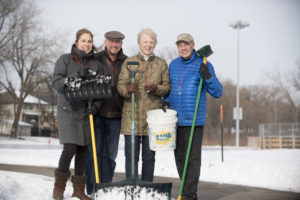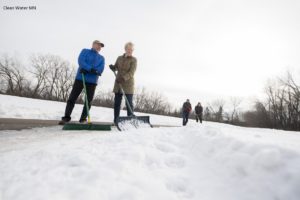Road Salt: Less is More

Minnesota Water Stewards tackle oversalting
Since August, a devoted volunteer group of trained Minnesota Water Stewards (Randy Holst, Joe Knaeble, Walter Levesque, and Louann Waddick) have joined efforts as the StopOverSalting (SOS) water quality working group.
Motivated by their awareness that Minnesota’s waterways and wells are rapidly becoming permanently and irreversibly polluted, SOS is supporting limited liability legislation that will reduce over-salting.
Read the full article on the Clean Water MN website below.

Using salt responsibly
While salt is an important tool in keeping everyone safe in the winter, you can use these tips to make sure you are applying just enough to do the job.
- Shovel that snow. The more snow that you can shovel or snow blow, the less salt you will need. Get out early and keep up with the storm.
- Apply less. Use less than four pounds of salt per 1,000 square feet. One pound of salt is about a heaping 12-ounce cup.
- Leave space between granules. There should be about 3 inches between each salt granule. A handheld spreader will help you achieve this spread pattern. This should provide enough melting power to break the bond between the snow/ice and the pavement, so the material can be shoveled.
- Switch. Most salts stop working below 15° Fahrenheit (pavement temperature), so should not be applied. Instead, use a small amount of sand for traction.
- Sweep up extra. Salt and sand on dry pavement is not doing any work and will be washed into the creek. Sweep up the extra and reuse it.
Learn more:
Stopoversalting.org
How to hire a contractor that uses best salt practices (PDF)
Ninemilecreek.org/get-involved/learn/salt-reduction/
